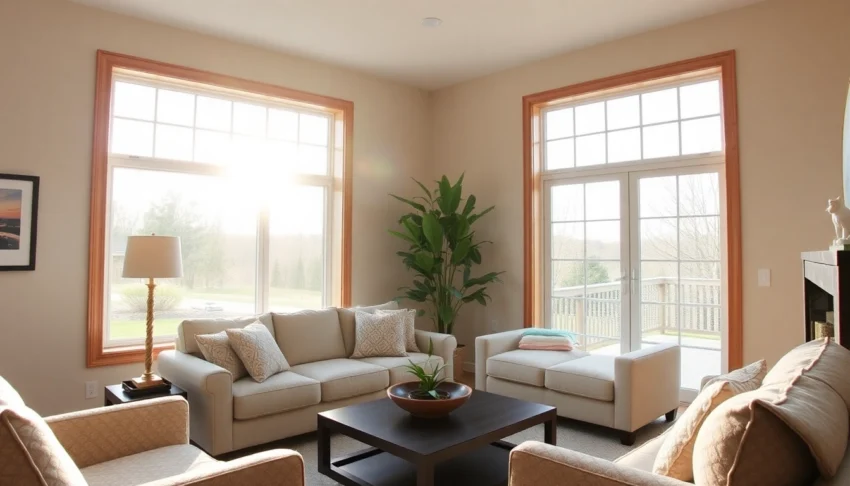Upgrading to replacement windows delivers energy savings, improved comfort, and enhanced home value. For homeowners planning a refresh, Replacement Windows offer a proven path to lower utility bills and better living conditions.
Why Replacement Windows Matter for Modern Homes
Energy Savings with Replacement Windows
Modern replacement windows are engineered to reduce heat transfer through advanced glazing, low-emissivity coatings, and improved frame insulation. By selecting windows with low U-values and high solar heat gain coefficients appropriate to your climate, you can tighten overall energy use, maintaining comfortable indoor temperatures with less strain on heating and cooling systems. Proper installation further enhances performance, ensuring airtight seals and consistent performance over time.
Enhanced Comfort and Natural Light
Replacement windows minimize drafts and cold spots that commonly occur around old frames. With better seals and improved glazing, rooms stay more evenly lit and comfortable throughout the day. Increased natural light without excessive glare can also reduce the need for artificial lighting, contributing to energy efficiency and a brighter living space.
Long-Term Value and Home Equity
Beyond immediate utility savings, new windows boost curb appeal, reduce exterior maintenance, and can positively influence resale value. A well-executed window upgrade is often perceived as a sign of quality and modernity by prospective buyers, which can translate into a stronger market position when it’s time to sell.
Choosing the Right Replacement Windows
Window Types and Features to Consider
Think about the operating style (casement, double-hung, sliding, or fixed/picture) based on how you use each room, air circulation needs, and ease of cleaning. Look for features that enhance energy performance—high-performance glazing, insulated frames, weatherstripping, and secure hardware. Grilles and patterns should complement your home’s architectural character while maintaining functional daylight levels.
Materials Comparison: Vinyl, Wood, Aluminum
Vinyl offers excellent value, low maintenance, and strong moisture resistance, making it a common choice for many homes. Wood exudes classic aesthetics and can be tailored with finishes but requires regular upkeep. Aluminum is durable and slim-framed, often paired with composite or insulated components for better energy performance. Your climate, budget, and maintenance tolerance should guide the material decision, with attention to long-term performance and environmental impact.
Warranty, Brands, and Service Commitments
Warranty terms vary by brand but typically cover frame integrity, finish, and hardware for multi-year to lifetime periods. When choosing brands, evaluate not only the product warranty but also the installer’s workmanship guarantee and service responsiveness. A strong combination of manufacturer coverage and installer accountability reduces long-term risk and provides peace of mind.
Installation Process and Best Practices
Pre-Installation Measurements and Prep
Accurate measurements are the foundation of a leak- and draft-free installation. Professionals check rough openings, square corners, and verify sill heights while protecting surrounding finishes. Preparing by removing coverings and clearing the work area minimizes delays and ensures accurate fitment from day one.
Full Frame vs Retrofit: Which Fits Your Home?
A full-frame replacement removes the entire window assembly, including trim and weather barriers, offering the best long-term sealing and a refreshed interior look. Retrofit (or pocket) replacement preserves the existing frame and can be quicker and less disruptive, but it may require careful assessment for moisture and structural integrity within the existing opening. The choice depends on window condition, wall structure, and desired outcomes.
Common Installation Pitfalls to Avoid
Common issues include inadequate flashing to prevent water intrusion, incomplete sealing that invites drafts, and improper attachment that can compromise performance in wind or impact conditions. Selecting a reputable installer with proven methods, proper tooling, and a detailed warranty policy helps mitigate these risks and ensures a durable result.
Cost, Financing, and ROI
Estimating Replacement Windows Costs
Costs vary with window type, size, material, glazing, and labor. A basic unit may be more affordable, while premium designs with advanced coatings and larger frames can elevate totals. For broader budgeting, many projects fall in the mid-to-upper range when considering multiple openings, professional installation, and finishing touches like trim and flashing.
Financing Options for Window Projects
Financing choices include manufacturer-based programs, home equity lines of credit, and energy-efficiency rebates where available. Spreading costs over time can make an upgrade more accessible, especially when the project includes high-performance glazing or custom finishes. Evaluate interest rates, payoff timelines, and any utility or local incentives to optimize total cost of ownership.
ROI: Energy Savings and Comfort Benefits
Energy savings contribute to a meaningful return over the life of the windows, often complemented by enhanced daily comfort and reduced maintenance needs. While exact payback depends on climate, home orientation, and usage, aligning window choices with high-performance ratings and durable installation generally yields a robust, multi-year return on investment.
Maintenance and Longevity
Care, Cleaning, and Seal Checks
Regular cleaning of panes and frames preserves appearance and function. Inspect seals, weatherstrips, and hardware for signs of wear, and address any gaps or moisture promptly to prevent deterioration. A simple routine of seasonal checks helps maintain optimal performance.
Seasonal Maintenance for Longevity
Seasonal tasks such as resealing joints, re-caulking where needed, and ensuring proper drainage away from the sill are key. For wooden frames, periodic interior and exterior refinishing protects against humidity and temperature swings. Proactive maintenance extends the life of both the units and surrounding walls.
Planning for Future Replacements
Keep documentation of product specifications, warranty terms, and installation details. Maintaining a replacement plan ensures you’re prepared for eventual upgrades before performance declines, enabling smoother budgeting and scheduling when the time comes.
